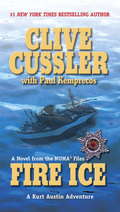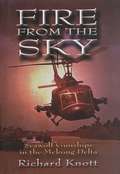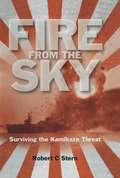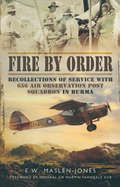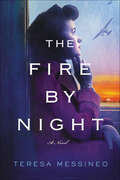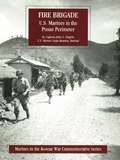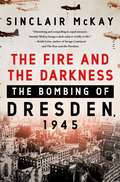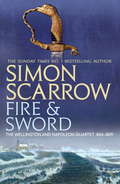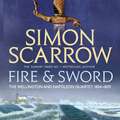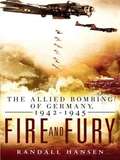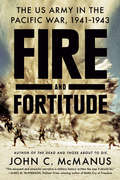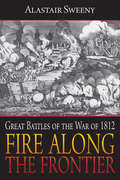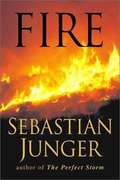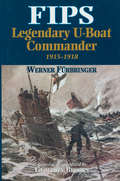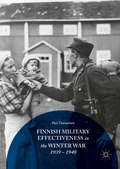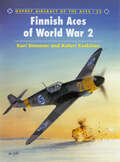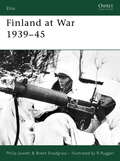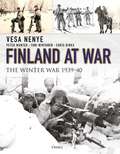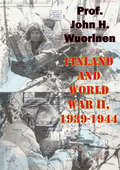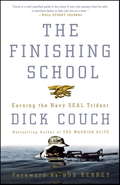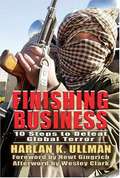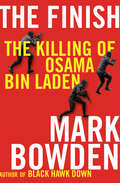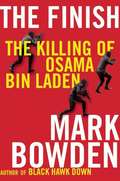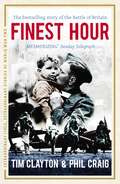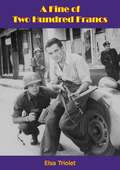- Table View
- List View
Fire Ice (NUMA Files #3)
by Clive Cussler Paul KemprecosIn his novels Serpent and Blue Gold, #1 bestselling author Clive Cussler introduced a hero for the new millennium: Kurt Austin, the leader of NUMA's Special Assignment Team, and an instant hit with critics and fans. Tulsa World said, "As always, Cussler twists fact and fiction into a rope of tension that will leave you dangling until the last page."<P> Now Kurt Austin returns to tackle his most dangerous mission to date... In the heart of the old Soviet Union, a mining tycoon is determined to overthrow the Russian government-distracting the U. S. with a man-made natural disaster using a notoriously unstable compound known as "fire ice." Detonation of this compound could create a tidal wave big enough to destroy a major city. But Kurt Austin and his Special Assignment Team are about to make a few waves of their own....
Fire from the Sky
by Richard C. KnottThis is the dramatic history of the HAL-3 Seawolves, the U.S. Navy's first and only helicopter gunship squadron of the Vietnam War. The squadron was established "in country" to support the fast, pugnacious river patrol boats of the brown water navy. Flying combat-worn Hueys borrowed from the Army, the mission of the Seawolves quickly expanded to include rapid response air support to any friendly force in the Delta needing immediate, no-holds-barred assistance. Operating in two-plane detachments from specifically configured LSTs, hastily constructed bases, and primitive campsites, the navy gunships and their crews responded to calls within minutes. Flying in all kinds of weather, day and night, they arrived at tree-top level with forward-firing rockets and flex-guns blazing. Door gunners hung outside the violently maneuvering helicopters delivering a hail of fire with their hand-held M-60 machine guns. The Seawolves inserted SEALs deep into enemy territory, and extracted them, often despite savage enemy opposition. They rescued friendly combatants from almost certain capture or death, and evacuated the wounded when Medevac helicopters were not available.Gleaned from historical documents and the colorful recollections of more than sixty Seawolf warriors, this is the first complete history of the most decorated Navy squadron of the Vietnam War. Naval aviator Richard Knott recounts the story of the Seawolves from the dawning of the concept to the moment the last squadron commander turned out the lights.
Fire From the Sky: Surviving the Kamikaze Threat
by Robert C. StemBy late 1944 the war in the Pacific had turned decisively against the Japanese, and overwhelming Allied forces began to close in on the home islands. At this point Japan unveiled a terrifying new tactic: the suicide attack, or Kamikaze, named after the Divine Wind which had once before, in medieval times, saved Japan from invasion. Intentionally crashing bomb-laden aircraft into Allied warships, these piloted guided missiles at first seemed unstoppable, calling into question the naval strategy on which the whole war effort was based.This book looks at the origins of the campaign, at its strategic goals, the organization of the Japanese special attack forces, and the culture that made suicide not just acceptable, but honourable. Inevitably, much mythology has grown up around the subject, and the book attempts to sort the wheat from the chaff. One story that does stand up is the reported massive stock-piling of kamikaze aircraft for use against any Allied invasion of the home islands, if the atomic bombs had not forced Japans surrender.However, its principal focus is on the experience of those in the Allied fleets on the receiving end of this peculiarly alien and unnerving weapon how they learnt to endure and eventually counter a threat whose potential was over-estimated, by both sides. In this respect, it has a very modern resonance.
Fire by Order: Recollections of Service with 656 Air Observation Post Squadron in Burma
by E. W. Maslen-JonesPerhaps the most surprising thing about this book is the fact that it has waited fifty years to appear for, as Sir Martin Farndale points out in his foreword, the debt owed by 14th Army to 656 Air OP Squadron in the reconquest of Burma was immeasurable. From 1943 until the end of the war, these three flights of five tiny Auster aircraft provided air observation for the whole of the Army fighting the Japanese in the jungle below. A likely explanation, if Ted Maslen- Jones is typical of his colleagues, is that they were essentially modest men who, in their own eyes, were only doing their job and were in fact rather privileged to be sailing above the canopy while the ground troops were slogging it out somewhere below them. Several times the author refers to the sheer exhilaration of flying over that beautiful but still unhappy country.Now, at last, thanks to the recollections, as well as the diligent research of Ted Maslen-Jones, the true contribution of these 'daring men in their flying machines' can be properly appreciated. As one of the pilots, his own memories are naturally of his flying time, but he never loses sight of the fact that it was the efforts of the fitters, signallers and drivers who kept these flimsy aircraft in the air and rightly points out that the record of serviceability of 656 Squadron was truly remarkable.
The Fire by Night: A Novel
by Teresa MessineoThe International Bestselller!A powerful and evocative debut novel about two American military nurses during World War II that illuminates the unsung heroism of women who risked their lives in the fight—a riveting saga of friendship, valor, sacrifice, and survival combining the grit and selflessness of Band of Brothers with the emotional resonance of The Nightingale.In war-torn France, Jo McMahon, an Italian-Irish girl from the tenements of Brooklyn, tends to six seriously wounded soldiers in a makeshift medical unit. Enemy bombs have destroyed her hospital convoy, and now Jo singlehandedly struggles to keep her patients and herself alive in a cramped and freezing tent close to German troops. There is a growing tenderness between her and one of her patients, a Scottish officer, but Jo’s heart is seared by the pain of all she has lost and seen. Nearing her breaking point, she fights to hold on to joyful memories of the past, to the times she shared with her best friend, Kay, whom she met in nursing school.Half a world away in the Pacific, Kay is trapped in a squalid Japanese POW camp in Manila, one of thousands of Allied men, women, and children whose fates rest in the hands of a sadistic enemy. Far from the familiar safety of the small Pennsylvania coal town of her childhood, Kay clings to memories of her happy days posted in Hawaii, and the handsome flyer who swept her off her feet in the weeks before Pearl Harbor. Surrounded by cruelty and death, Kay battles to maintain her sanity and save lives as best she can . . . and live to see her beloved friend Jo once more.When the conflict at last comes to an end, Jo and Kay discover that to achieve their own peace, they must find their place—and the hope of love—in a world that’s forever changed. With rich, superbly researched detail, Teresa Messineo’s thrilling novel brings to life the pain and uncertainty of war and the sustaining power of love and friendship, and illuminates the lives of the women who risked everything to save others during a horrifying time.
FIRE BRIGADE: U.S. Marines In The Pusan Perimeter [Illustrated Edition] (Marines In The Korean War Commemorative Series #4)
by Captain John J. Chapin USMCIncludes over 30 maps, photos and illustrations.The Battle of Pusan Perimeter was a large-scale battle between United Nations and North Korean forces lasting from August 4 to September 18, 1950. It was one of the first major engagements of the Korean War. An army of 140,000 UN troops, having been pushed to the brink of defeat, were rallied to make a final stand against the invading North Korean army, 98,000 men strong.UN forces, having been repeatedly defeated by the advancing North Koreans, were forced back to the "Pusan Perimeter", a 140-mile (230 km) defensive line around an area on the southeastern tip of the Korean Peninsula that included the port of Pusan. The UN troops, consisting mostly of forces from the Republic of Korea (ROK), United States and United Kingdom, mounted a last stand around the perimeter, fighting off repeated North Korean attacks for six weeks as they were engaged around the cities of Taegu, Masan, and P'ohang, and the Naktong River. The massive North Korean assaults were unsuccessful in forcing the United Nations troops back further from the perimeter, despite two major pushes in August and September.North Korean troops, hampered by supply shortages and massive losses, continually staged attacks on UN forces in an attempt to penetrate the perimeter and collapse the line. However, the UN used the port to amass an overwhelming advantage in troops, equipment, and logistics, and its navy and air forces remained unchallenged by the North Koreans during the fight. After six weeks, the North Korean force collapsed and retreated in defeat after the UN force launched a counterattack at Inchon on September 15. The battle would be the furthest the North Korean troops would advance in the war, as subsequent fighting ground the war into a stalemate.
The Fire and the Darkness: The Bombing of Dresden, 1945
by Sinclair McKayA gripping work of narrative nonfiction recounting the history of the Dresden Bombing, one of the most devastating attacks of World War II.On February 13th, 1945 at 10:03 PM, British bombers began one of the most devastating attacks of WWII: the bombing of Dresden. The first contingent killed people and destroyed buildings, roads, and other structures. The second rained down fire, turning the streets into a blast furnace, the shelters into ovens, and whipping up a molten hurricane in which the citizens of Dresden were burned, baked, or suffocated to death. Early the next day, American bombers finished off what was left. Sinclair McKay’s The Fire and the Darkness is a pulse-pounding work of history that looks at the life of the city in the days before the attack, tracks each moment of the bombing, and considers the long period of reconstruction and recovery. The Fire and the Darkness is powered by McKay’s reconstruction of this unthinkable terror from the points of view of the ordinary civilians: Margot Hille, an apprentice brewery worker; Gisela Reichelt, a ten-year-old schoolgirl; boys conscripted into the Hitler Youth; choristers of the Kreuzkirche choir; artists, shop assistants, and classical musicians, as well as the Nazi officials stationed there. What happened that night in Dresden was calculated annihilation in a war that was almost over. Sinclair McKay’s brilliant work takes a complex, human, view of this terrible night and its aftermath in a gripping book that will be remembered long after the last page is turned.
Fire and Sword (The Wellington and Napoleon Quartet)
by Simon ScarrowFIRE AND SWORD is the unputdownable third novel in Simon Scarrow's bestselling Wellington and Napoleon Quartet. A must read for fans of Robert Harris.1804. Napoleon Bonaparte is Emperor of France, his ultimate aim: to rule Europe. After defeat at the Battle of Trafalgar, he wins a glorious victory against Austria at Austerlitz. He then deposes the Spanish king and places his own brother on the throne. But he is yet to triumph over his most hated enemy: Great Britain.Arthur Wellesley (the future Duke of Wellington) throws himself into the British campaign in Europe. After glory in Portugal, he commands the army in a series of triumphant battles across Spain. For those living reluctantly under French rule, his victories suggest that Napoleon's progress is not inexorable: freedom can be restored...
Fire and Sword: (Revolution 3) (The Wellington and Napoleon Quartet)
by Simon ScarrowFIRE AND SWORD is the unputdownable third novel in Simon Scarrow's bestselling Wellington and Napoleon Quartet. A must read for fans of Robert Harris.1804. Napoleon Bonaparte is Emperor of France, his ultimate aim: to rule Europe. After defeat at the Battle of Trafalgar, he wins a glorious victory against Austria at Austerlitz. He then deposes the Spanish king and places his own brother on the throne. But he is yet to triumph over his most hated enemy: Great Britain.Arthur Wellesley (the future Duke of Wellington) throws himself into the British campaign in Europe. After glory in Portugal, he commands the army in a series of triumphant battles across Spain. For those living reluctantly under French rule, his victories suggest that Napoleon's progress is not inexorable: freedom can be restored...(P)2017 Headline Digital
Fire and Fury
by Randall HansenNational Bestseller An enlightening and utterly convincing re-examination of the allied aerial bombing campaign and of civilian German suffering during World War II–an essential addition to our understanding of world history. During the Second World War, Allied air forces dropped nearly two million tons of bombs on Germany, destroying some 60 cities, killing more than half a million German citizens, and leaving 80,000 pilots dead. Much of the bombing was carried out against the expressed demands of the Allied military leadership. Hundreds of thousands of people died needlessly. Focusing on the crucial period from 1942 to 1945, and using a compelling narrative approach, Fire and Fury tells the story of the American and British bombing campaign through the eyes of those involved: military and civilian command in America, Britain, and Germany, aircrew in the sky, and civilians on the ground. Acclaimed historian Randall Hansen shows that the Commander-in-Chief of Bomber Command, Arthur Harris, was wedded to an outdated strategy whose success had never been proven; how area bombing not only failed to win the war, it probably prolonged it; and that the US campaign, which was driven by a particularly American fusion of optimism and morality, played an important and largely unrecognized role in delivering Allied victory. From the Hardcover edition.
Fire and Fortitude: The US Army in the Pacific War, 1941-1943
by John C. McManusAn engrossing, epic history of the US Army in the Pacific War, from the acclaimed author of The Dead and Those About to Die“This eloquent and powerful narrative is military history written the way it should be.”—James M. McPherson, Pulitzer Prize-winning historian "Out here, mention is seldom seen of the achievements of the Army ground troops," wrote one officer in the fall of 1943, "whereas the Marines are blown up to the skies." Even today, the Marines are celebrated as the victors of the Pacific, a reflection of a well-deserved reputation for valor. Yet the majority of fighting and dying in the war against Japan was done not by Marines but by unsung Army soldiers. John C. McManus, one of our most highly acclaimed historians of World War II, takes readers from Pearl Harbor—a rude awakening for a military woefully unprepared for war—to Makin, a sliver of coral reef where the Army was tested against the increasingly desperate Japanese. In between were nearly two years of punishing combat as the Army transformed, at times unsteadily, from an undertrained garrison force into an unstoppable juggernaut, and America evolved from an inward-looking nation into a global superpower. At the pinnacle of this richly told story are the generals: Douglas MacArthur, a military autocrat driven by his dysfunctional lust for fame and power; Robert Eichelberger, perhaps the greatest commander in the theater yet consigned to obscurity by MacArthur's jealousy; "Vinegar Joe" Stillwell, a prickly soldier miscast in a diplomat's role; and Walter Krueger, a German-born officer who came to lead the largest American ground force in the Pacific. Enriching the narrative are the voices of men otherwise lost to history: the uncelebrated Army grunts who endured stifling temperatures, apocalyptic tropical storms, rampant malaria and other diseases, as well as a fanatical enemy bent on total destruction. This is an essential, ambitious book, the first of two volumes, a compellingly written and boldly revisionist account of a war that reshaped the American military and the globe and continues to resonate today.
Fire Along the Frontier: Great Battles of the War of 1812
by Alastair SweenyA view of the War of 1812 from a social perspective. This book provides a fresh new view of the battles of the war and goes behind the scenes to explore wartime trading activity, particularly American dealings with Napoleon and cross-border commerce, as well as the activities of John Jacob Astor, America’s richest man and war financier, and his fur-trading partners in Montreal.There was a wealth of military screw-ups. What did the generals do before each battle to lose it, and what could they have done to win? And did the incompetence and mixed loyalties of Military Governor Sir George Prevost, grandson of a financier of the American Revolution and nephew by marriage of Vice President Aaron Burr, nearly lose Canada for the British?The book also provides glimpses of some of the fascinating behind-the-scenes players, such as legendary but flawed President Thomas Jefferson, and President Madison’s wife, Dolley, who could have won the war single-handedly had she been able to get all the generals together in the same drawing room.
Fire
by Sebastian JungerSebastian Junger details his first-hand experiences as he describes fire fighting. As a seasoned journalist he travels the world and brings the reader face to face with many crises.
Fips: Legendary U-Boat Commander, 1915–1918
by Geoffrey Brooks Werner FürbringerWeuner Frbringer (Fips) became one of the most successful U-Boat commanders in WW1 through a blend of skill, daring and, by his own typically modest admission, sheer luck. This vivid memoir, never before published in English, makes compelling reading.This is an inspiring and chivalrous story; it is ironic then that, when finally sunk by the Royal Navy off the East Coast of England, Fips was machine-gunned in the water, contrary to repeated Government denials of such behaviour.
Finnish Military Effectiveness in the Winter War, 1939-1940
by Pasi TuunainenThis book analyzes the multi-faceted phenomenon of Finnish military effectiveness in the Winter War (1939-40). Drawing on a wide array of primary and secondary sources, Pasi Tuunainen shows how by focusing on their own strengths and pitting these against the weaknesses of their adversary, the Finns were able to inflict heavy casualties on the Red Army whilst minimizing their own losses. The Finns were able to use their resources for effective operational purposes, and perform almost to their full potential. The Finnish small-unit tactics utilized the terrain and Arctic conditions for which they had prepared themselves, as well as forming cohesive units of well-motivated and qualitatively better professional leaders and citizen soldiers who could innovate and adapt. The Finnish Army had highly effective logistics, support and supply systems that kept the troops fighting.
Finnish Aces of World War 2
by Kari StenmanAlways outnumbered by their Soviet counterparts, the small band of Finnish fighter pilots who defended their Scandinavian homeland from the 'communist hordes' in three separate wars between 1939 and 1945 amassed scores only bettered by the Luftwaffe's Jagdflieger. Initially equipped with a motley collection of biplane and monoplane fighters garnered from sources across the globe, the Finnish Air Force was thrust into combat in November 1939. Given little chance against the massive Soviet force, the Finnish fighter pilots confounded the sceptics and decimated the attacking fighter and bomber formations, prompting the Russians to call a halt in March 1940. This scenario was repeated in 1941, and by 1943 the Finns had become uneasy allies with the Germans. Complete with first-hand accounts and detailed colour illustrations, this book profiles aces like Juutilainen and Wind, who proved unbeatable in the final months of conflict.
Finland at War 1939-45
by Philip Jowett Raffaele RuggeriIn the face of Soviet invasion in 1939-40, and once again in 1941-44, the armies raised by Finland - a tiny nation of only 4 million people - astonished the world by their effective resistance. At the end of both these campaigns - the Winter War, and the Continuation War - the fiercely patriotic defiance of vastly stronger Soviet forces by Marshal Mannerheim's soldiers won their country a unique prize: although forced to accept harsh terms, Finland was never occupied by the Red Army, and retained its independence. This book explains and illustrates, for the first time in English, the organization, uniforms, equipment and tactics of Finland's defenders.
Finland at War: The Winter War 1939-40
by Vesa NenyeThe story of the 'Winter War' between Finland and Soviet Russia is a dramatic David versus Goliath encounter. When close to half a million Soviet troops poured into Finland in 1939 it was expected that Finnish defences would collapse in a matter of weeks. But they held firm. The Finns not only survived the initial attacks but succeeded in inflicting devastating casualties before superior Russian numbers eventually forced a peace settlement. This is a rigorously detailed and utterly compelling guide to Finland's vital, but almost forgotten role in the cataclysmic World War II. It reveals the untold story of iron determination, unparalleled skill and utter mastery of winter warfare that characterized Finland's fight for survival on the hellish Eastern Front. Finland at War: the Winter War 1939-40 is the premiere English-language history of the fighting performance of the Finns, drawing on first-hand accounts and previously unpublished photographs to explain just how they were able to perform military feats that nearly defy belief.
Finland And World War II, 1939-1944
by Prof. John H. WuorinenFinland gained its independence from Russia in 1917 during the turmoil of the Russian Civil War, and ever since the communist leaders cast envious eyes toward their former domain; only waiting for a chance to invade. With the rise of Hitler's Germany the face of Europe changed, agreements were reached between the Soviets and the Nazis in brutally dividing up a nigh-defenceless and the detente culminated in the Non-Aggression Pact of 1939. This gave Stalin and his cohorts a chance to expand their borders, whilst Hitler looked west at France and Britain, by launching an attack directed to recapture their former Grand Duchy. Thus started Finland's participation in the Second World War. This book eloquently recounts the stubborn resistance of the Finns against the Soviet attack during the Winter War, the horrific siege of Leningrad and the Finns brave bid to retain its independence from Soviet dominance. The manuscript for the book was smuggled out of Soviet controlled Finland in late 1945, it was passed to Professor Wuorinen who skilfully edited and annotated the work into its present form.A fascinating sidelight on a little known corner of the brutal Second World War.
The Finishing School: Earning the Navy SEAL Trident
by Dick CouchIn America's new war, the first guns in the fight are special operations forces, including the Navy SEALs, specially trained warriors who operate with precision, swiftness, and lethal force. In the constantly shifting war on terror, SEAL units--small in number, flexible, stealthy, and efficient--are more vital than ever to America's security as they take the battle to an elusive enemy around the globe. But how are Navy SEALs made? What special training and preparation sharpen the physical skills and intangible character of a regular soldier into that of an elite warrior? In the acclaimedWarrior Elite, former Navy SEAL Dick Couch narrated one SEAL class's journey through BUD/S training, the brutal initial course that separates out candidates with the character and stamina necessary to begin training as Navy SEALs. InThe Finishing School, Couch follows SEALs into the next levels of training, where they further develop their endurance and strength, but also learn the teamwork and finely honed skills they'll need to fight with the best--and win. Dick Couch spent six months living with and observing SEALs in training for operational readiness in the months leading up to the Iraqi campaign. He follows them on the ground and in the water as they undergo SEAL Tactical Training, where they master combat skills such as precision shooting, demolitions, secure communications, parachuting, diving, and first aid. From there, the men enter operational platoons, where they subordinate their individual abilities to the mission of the group and train for special operations in specific geographical environments. Never before has a civilian writer been granted such close access to the training of America's most elite military forces. The Finishing Schoolis essential reading for anyone who wants to know what goes into the making of America's best warriors.
Finishing Business: Ten Steps to Defeat Global Terror
by Harlan K. UllmanUllman examines the underlying causes and political motivations that drive global terrorism. He analyzes the attraction that Jihadist Extremism holds for disaffected Muslims around the world and argues that American governance is currently not up to the task of keeping the nation safe. He then describes ten concrete steps America can take to defeat global terror. Ullman is a columnist for the Washington Times.
The Finish: The Killing of Osama bin Laden
by Mark BowdenFrom Mark Bowden, the preeminent chronicler of our military and special forces, comes The Finish, a gripping account of the hunt for Osama bin Laden. With access to key sources, Bowden takes us inside the rooms where decisions were made and on the ground where the action unfolded.After masterminding the attacks of September 11, 2001, Osama bin Laden managed to vanish. Over the next ten years, as Bowden shows, America found that its war with al Qaeda-a scattered group of individuals who were almost impossible to track-demanded an innovative approach. Step by step, Bowden describes the development of a new tactical strategy to fight this war-the fusion of intel from various agencies and on-the-ground special ops. After thousands of special forces missions in Iraq and Afghanistan, the right weapon to go after bin Laden had finally evolved. By Spring 2011, intelligence pointed to a compound in Abbottabad; it was estimated that there was a 50/50 chance that Osama was there. Bowden shows how three strategies were mooted: a drone strike, a precision bombing, or an assault by Navy SEALs. In the end, the President had to make the final decision. It was time for the finish.
The Finish: The Killing of Osama Bin Laden
by Mark BowdenThe best-selling author of Black Hawk Down tells the story of the hunt for Osama bin Laden, based on extensive reporting, analysis, and interviews with President Obama, his national security staff, former SEALs, CIA officers, and others who can not be named.
Finest Hour: The bestselling story of the Battle of Britain (Extraordinary Lives, Extraordinary Stories of World War Two #3)
by Phil Craig Tim ClaytonSeventy years ago, Europe lay at Hitler's feet. Britain faced its darkest hour - outnumbered and friendless as the German army continued its advance. Defeat or capitulation seemed inevitable. But instead a legend was born. Taking its readers on a breathtaking journey from open lifeboats in Atlantic gales to the cockpits of burning fighter-planes, and through cities devastated by the Blitz, FINEST HOUR recreates the terror, the tragedy and the triumph of the Battle of Britain. This powerful account of the events of 1940 is told through the voices, diaries, letters and memoirs of the men and women who lived, loved, fought and died during this terrible yet inspiring year. FINEST HOUR blends original historical research with the experiences of ordinary people in desperate times. Cutting through the nostalgic haze, this book enables readers to experience a time - still within living memory - when a nations's darkest hour became its finest.
A Fine of Two Hundred Francs
by Elsa Triolet‘You or I would walk barefoot in the snow to save an unknown comrade from death. We have learned to kill...the traitors’It is the winter of 1942. Juliette Noël moves silently through Occupied France, trudging across the snowy countryside, working for the Resistance, always just one move ahead of the Gestapo. The painter Alexis Slavsky must conceal his Jewish blood. As he drifts-from Montparnasse to Lyons to the Alps—the precariousness of his Bohemian life becomes intensified by the exigencies of war. Russian-born Louise has survived Nazi interrogation and escaped from a concentration camp. Now she lies low in a ‘safe’ house, waiting to rejoin the maquis.First published illegally by Underground presses, these extraordinary stories of the French Resistance are a moving and shocking testament to the courage of those caught up by the nightmare of war.
